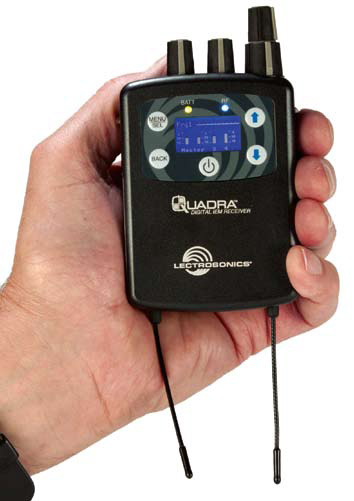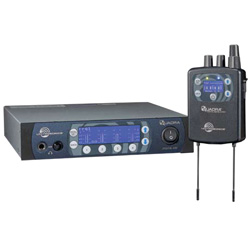The new Lectrosonics Quadra , which is being introduced at the 2011 Winter NAMM Show, is a ground-breaking digital wireless in-ear monitor system that provides four channels of full-fidelity audio that users can mix themselves from a beltpack.
Quadra operates license-free in what’s called the 915 MHz ISM band, which is between 902 and 928 MHz.
Pro audio regularly has me-too products and incremental upgrades. Rarely do truly innovative inventions significantly change expectations about sound quality and performance.
This is one of those defining moments for Lectrosonics, an engineering based manufacturer of wireless systems based in Rio Rancho, NM. In case you haven’t heard much about them, they’re the Microsoft of wireless audio for TV and film production, and have the lion’s share of that market.
In 2002, Lectrosonics introduced superior wireless technology with the Hybrid Digital UHF systems that eliminate the artifacts of FM analog wireless transmission by transmitting a digitally-encoded signal over an analog carrier.
The R400a has also become a mainstay of high-end touring guitarists who want to maintain tone and attack while playing wireless. In fact, the R400a’s response is so accurate that it’s the only wireless system recommended for measurement microphones used with (Rational Acoustics) Smaart and other FFT measurement systems.
Two years ago, Lectrosonics debuted the D4, a 4-channel digital wireless audio link developed mainly for location production in film and TV.
The 24-bit, 48 kHz system employs spread spectrum digital wireless technology. This communications technology, originally developed for the military, deliberately uses about 10 times more RF bandwidth than needed to transmit a signal by constantly hopping around on different frequencies.
Spread spectrum’s advantages – it’s hard to detect, intercept, and is resistant to jamming – aren’t especially important to wireless entertainment, but it does add resistance to interference from other transmissions.

The Future Is Now
ISM stands for industrial, scientific and medical. The main reason for using the ISM band is because interference-free options for unlicensed wireless operation in the U.S. going forward are limited to three areas of TV spectrum: a handful of VHF frequencies, the first open 6 MHz-wide UHF TV channel above and below TV 37, and in unoccupied channels below TV 21 next to existing broadcasters in major metropolitan areas.
The 915 MHz ISM band is more attractive than the 2.4 GHz “WiFi & Bluetooth” spectrum because there’s less interference and its radio propagation characteristics are better.
Existing users of the 915 MHz ISM band include E-ZPass for toll booths and a few other older radio frequency identification (RFID) systems, some scientific telemetry, medical equipment, and older cordless phones.
Most cordless phones have moved to the 1.9, 2.4 or 5.8 GHz bands. In general, the 915 ISM band is relatively uncongested, especially when compared to the 2.4 GHz band.















